A History of the County of York North Riding: Volume 1. Originally published by Victoria County History, London, 1914.
This free content was digitised by double rekeying. All rights reserved.
'Parishes: Middleton Tyas', in A History of the County of York North Riding: Volume 1, ed. William Page (London, 1914), British History Online https://prod.british-history.ac.uk/vch/yorks/north/vol1/pp190-197 [accessed 1 February 2025].
'Parishes: Middleton Tyas', in A History of the County of York North Riding: Volume 1. Edited by William Page (London, 1914), British History Online, accessed February 1, 2025, https://prod.british-history.ac.uk/vch/yorks/north/vol1/pp190-197.
"Parishes: Middleton Tyas". A History of the County of York North Riding: Volume 1. Ed. William Page (London, 1914), British History Online. Web. 1 February 2025. https://prod.british-history.ac.uk/vch/yorks/north/vol1/pp190-197.
In this section
MIDDLETON TYAS
Midelton (i-xiv cent.); Middleton Tiays (xiv cent.); Middleton Tyers (xvi cent.).
The area of this parish is 6,243 acres, 1,935 being arable land, 3,496 permanent grass and 84 woods and plantations. (fn. 1) The chief crops raised are wheat, oats, beans, barley and turnips. The subsoil is Yoredale Rocks and Magnesian Limestone, the soil partly clay. The parish is rich in minerals. There are several limestone quarries, ironstone has been traced, and Middleton was once famous for its mines of copper, although none seems to have been worked since the middle of the 18th century. In connexion with these days of prosperity it may be mentioned that there were sixteen public-houses in Middleton in 1820, two of which are now used as cottages. (fn. 2) The two branches of Watling Street that run from Piercebridge and Barnard Castle respectively to Catterick meet at Scotch Corner in this parish. A tumulus called the Five Hills lies north of Middleton Tyas village, from which Middleton Tyas Lane runs to form four cross-roads at Scotch Corner. The village is large, and is chiefly grouped round two roads. The church, approached by a short road, lies below the village to the east, the churchyard being on the bank of the small Kirk Beck, which flows south through the parish. The upper part of the village is grouped round a small green, upon which is a maypole. The tiled roofs, varied stone and irregular construction of the houses have a very picturesque effect, particularly at the west end, where the houses on each side have small gardens between them and the road.
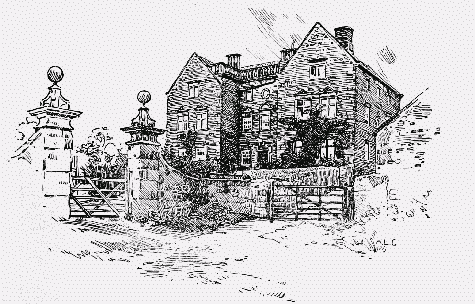
Moulton Manor-house, Middleton Tyas
The present vicarage is a little over a quarter of a mile from the church, but the previous building lies on the north side of the village, and is known as the Rookery. About the year 1750 Dr. Mawer, whose somewhat fulsome epitaph figures on the chancel wall, is reported in the registers as having carried on extensive and apparently remunerative copper workings in the glebe lands, particularly in the field known as Goose Hill, immediately to the south of the path to the church. Traces of these works are still to be seen in the mounds in this field as well as in the pieces of stone showing the marks of a furnace, which are often built into the houses of the village.
Rather more than a mile south of the village is South Moulton, with a manor-house and hall. The manor-house, now a farm-house, was rebuilt in the first half of the 17th century, and is a characteristic example of that period. Its front or east face has slightly projecting wings, with the principal entrance in the middle. The square doorway with a moulded architrave is flanked by two windows; over these is a moulded cornice or architrave stepped up over each window and twice over the doorway; the pair of ground-floor windows in each wing are similar. The first-floor windows all have moulded architraves and pediments over, the middle one (above the doorway) being a half-round. The wings are gabled and the middle space has a balustraded parapet. The interior has been more or less altered to suit later requirements, but the original black oak stair remains, though now covered with paint; it has twisted balusters and carved heads and pendants to the newels.
Moulton Hall, a 17th-century building of three stories, stands some way back from the road and is approached by a drive. The entrance front, facing east, has three gables, each with a hollow curve surmounted by a small pediment. The entrance is through a porch having a circular headed door with a frieze and cornice above it, surmounted by a pierced parapet. The whole of the front and sides—the latter containing two similar gables—is rusticated, the quoins being still more boldly rusticated. On each side of the panelled hall are large rooms, and behind is a finely carved staircase with a carved handrail, below which is a large Roman running acanthus ornament in the place of balusters, and having newels supporting beautiful oak vases, and their under sides carved drops. The lower windows, which are of three lights, have mullions and transoms with architraves supporting pediments, some segmental. The upper windows are of two lights with architraves, and above them are circular gable lights.
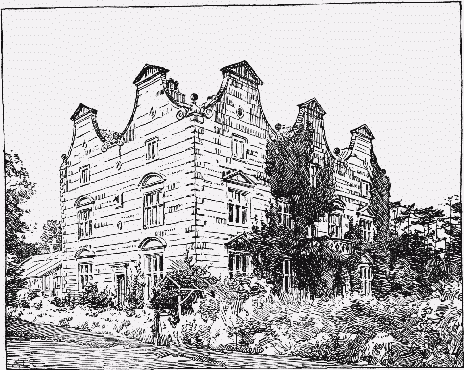
Moulton Hall, Middleton Tyas
One mile north-west of the village is Kneeton Hall, now a farm-house, a square building with a gable projecting to the front at the south end. A plain square-headed door opening into this portion of the house has the date a.d. 1597, followed by some illegible letters and 1616, inscribed above the head. The house is built of rubble with squared quoins and large stone-built chimneys. The southern gable and the west or back of the house have some mullioned and transomed windows, and the gables retain the apex stones and curved 'kneelers,' but beyond these there is no detail by which to date the various parts of the house, which probably existed at the end of the 16th century.
Near Kneeton Hall is a farm-house, known as Under Kneeton, east of the Street. There have been other houses here, pulled down of late years. (fn. 3) A small Wesleyan chapel was erected at Moulton in 1835, but the present building, built by Dennison Sanderson of Moulton Hall, (fn. 4) was opened in 1863. In 1877 a Primitive Methodist chapel was built. Gatherley Castle and part of Gatherley Moor (fn. 5) are in this parish.
Manors
MIDDLETON TYAS, Kneeton and Moulton in this parish were all land of Count Alan in 1086 (fn. 6) and were afterwards members of the honour of Richmond. (fn. 7) All three places belonged to Ulf before the Conquest, and Middleton and Kneeton by 1086 had passed to Ughtred, (fn. 8) who held of the count a 'manor' in each place with sac and soc. (fn. 9) Middleton and Kneeton were at first coupled together, (fn. 10) and the three joint owners were often said to hold a moiety or a third of a manor; but subsequent to the escheat of one of these shares to the Crown the whole was granted out as two lordships, and as such remained. The 7 carucates of land in Middleton were divided between two fees; the first consisted of 4 carucates, of which in 1286–7 (fn. 11) a little more than 2 were held in demesne. Meldred de Middleton and Gyllmichael his brother lived in the 12th century. (fn. 12) Meldred made grants in Middleton to St. Agatha's Abbey as did William his son, Thomas son of William and Richard son of Thomas. (fn. 13) The last-named with the assent of Clarice his wife in 1209 granted 2 oxgangs in Kneeton to St. Mary's Abbey, York, (fn. 14) and before or in 1211 he granted all his lands of Middleton and Kneeton—3½ carucates—to Gilbert son of Roger son of Reinfrid. (fn. 15) This Gilbert married Helewise, only child of William de Lancaster, and by her was father of the third William de Lancaster, Helewise, who married Peter de Bruce, Alice, who married William de Lindsey, (fn. 16) and Serota, who married Alan de Multon and died childless. The lands in Middleton appear to have passed exclusively to the heirs of Alice, for by 1283 (fn. 17) Walter son of William de Lindsey had been succeeded by his son William in the tenure of the whole of the quarter of a knight's fee here. William had an only child Christina, (fn. 18) who must have been married to Enguerrand V (Ingelram, Ingram) de Guines, head of the most powerful feudal house in the north of France. (fn. 19) He was returned as joint lord of Middleton and Kneeton in 1316. (fn. 20) In 1318 one-third of the manor of Middleton was settled on Enguerrand and Christina for their lives with successive remainders to their younger son (fn. 21) Robert de Guines, to Baldwin his brother and to his heirs, and finally to the right heirs of Christina. (fn. 22) In 1334 Christina was dead, and her son Robert de Guines (fn. 23) was able to establish his right to the profits of this fee. (fn. 24) During the French wars these lands were taken into the king's hands. (fn. 25) Baldwin must have died or forfeited, for William de Coucy, eldest son of Enguerrand and Christina, succeeded him. (fn. 26) Although he had not himself done homage or had livery he granted these lands to his son William, who in 1340 —at the interposition of the Count of Hainault, the king's father-in-law—had pardon for acquiring them and confirmation of his possession (fn. 27); and in the same year he obtained a grant of free warren to himself and his heirs. (fn. 28) Robert had demised the manor to William de Middleton for his own life, and William de Coucy died seised of rents and the reversion of the manor in 1341–2, and was succeeded by his brother Enguerrand VI, (fn. 29) who was killed at Crécy in 1346, his French domains having been devastated by the English. He left a young son Enguerrand VII, whom the English brought as a hostage to the court of Edward III. To assure himself a powerful influence in the north of France Edward gave him his daughter Isabel in marriage and made him Earl of Bedford. (fn. 30) In 1375 died Joan, widow of Sir John de Coupland, kt., who held the Coucy manors, including Middleton, by grant of the king for life, and the manors reverted by the king's grant to Enguerrand and Isabel and their issue. (fn. 31) Enguerrand VII was the last of the Coucys. His whole life was spent in warfare. On the death of his father-in-law Edward III he rallied to the French side. He took an active part in the campaign of Flanders in 1382 and in the invasion of Scotland. His remaining years were occupied by annoyances in his own domains caused by his son-inlaw Robert de Vere, Duke of Ireland. On his death in 1397 his lands were divided between his two daughters, Mary the elder succeeding to his possessions in France, (fn. 32) and Philippa the younger, Duchess of Ireland, receiving a grant from Richard II in 1399 of the manors of Middleton and Kneeton in general tail. (fn. 33) Philippa died childless in 1411, (fn. 34) and these manors escheated to the overlord and descended with the demesne lands of Richmond (q.v.) until 1546–7, (fn. 35) when they were granted to William Parr Earl of Essex in fee. (fn. 36) Created Marquess of Northampton in February 1546–7, he was attainted in 1553, (fn. 37) and, although he regained many of his lands on the accession of Queen Elizabeth, (fn. 38) these manors were not among the number.
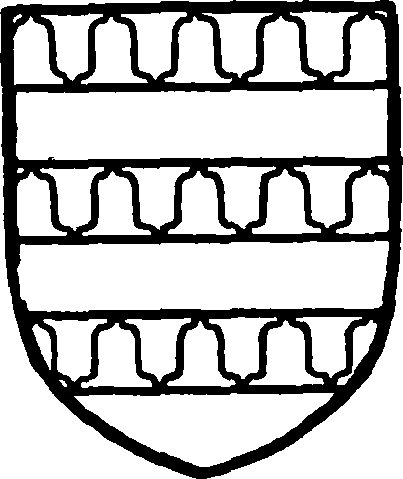
Coucy. Barry vair and gules.

Parr. Argent two bars azure and a border engrailed sable.
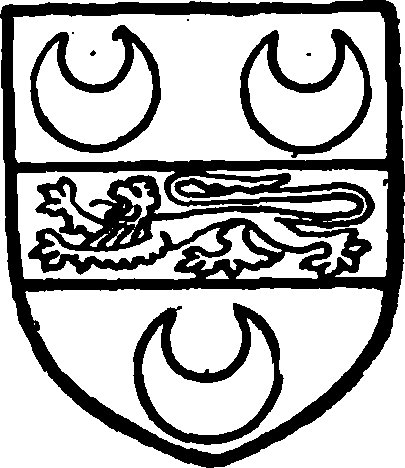
Boynton. Or a fesse between three crescents gules with a lion passant or upon the fesse.
In 1569–70 Roger Manwood, serjeant-at-law, (fn. 39) seemingly acting for the Crown, conveyed the manor of Middleton Tyas to Alice Strickland. (fn. 40) Alice, seised of half the manor, died a widow in 1588, leaving a son and heir Thomas Strickland, (fn. 41) but the manor was settled on her issue by her second husband (fn. 42) Sir Thomas Boynton. Sir Francis Boynton of Barmston (fn. 43) and Dorothy his wife made a settlement in 1613, (fn. 44) and Sir Francis Boynton died seised in 1617. (fn. 45) The manor was in 1651 conveyed by Sir Francis Boynton to Nicholas Shuttleworth, (fn. 46) and was still in the possession of the Shuttleworths of Forcett (q.v.) in 1773. (fn. 47) Leonard Lawley Hartley was owner in 1857, Leonard Laurie Hartley in 1879. (fn. 48) Mr. Colin Douglas Eyre was lord of the manor at his death in 1910, when he was succeeded by his brother Mr. Ralph Eyre, the present owner.
The second fee in Middleton Tyas held of the honour of Richmond was in 1286–7 composed of 2½ carucates, of which 2 carucates were held in demesne. (fn. 49) It was held until the 15th century by a branch of the family of Middleton that may have had for its ancestor Gyllmichael, brother of Meldred de Middleton. (fn. 50) John and Henry, sons of Gyllmichael, disputed between themselves the possession of certain lands here and at Kneeton in 1194 and 1209–10. (fn. 51) In 1268 a Henry de Middleton claimed the custody of the manor of Melsonby (q.v.) against Brian Fitz Alan, and in 1282 Henry de Middleton held a quarter-fee in Middleton of the Earl of Richmond. (fn. 52) He was living in 1286–7, when, besides his demesne lands in Middleton, he held 1 carucate of Roger Miniot in Kneeton. (fn. 53) Matthew de Middleton was returned as joint lord in 1316. (fn. 54) The Middletons continued to hold lands in Middleton and Kneeton (q.v.), and a William de Middleton was living in or about 1340, (fn. 55) but no connected history of this holding has been found.
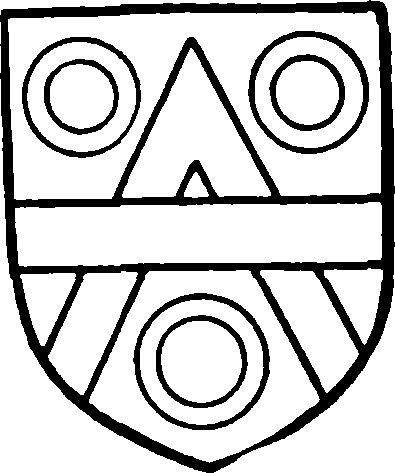
Hartley. Or a cheveron between three rings gules with a fesse azure over all.
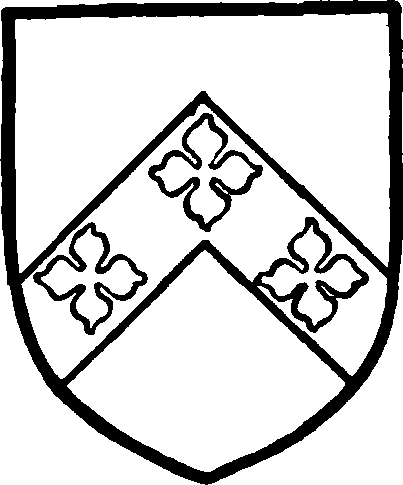
Eyre. Argent a cheveron sable with three quatrefoils or thereon.
KNEETON (Naton, xi cent.; Kneton, xiii–xvii cent.; Cneton, xiii cent.; Knighton, xvi, xvii cent.) was among the lands of Count Alan in 1086, (fn. 56) and afterwards became a member of the honour of Richmond. In 1286–7 the 5 carucates here were divided into two fees. (fn. 57) A mesne lordship over half a carucate was held at this time by William de Lindsey, (fn. 58) and this followed the descent of the manor of Middleton Tyas (fn. 59) (q.v.).
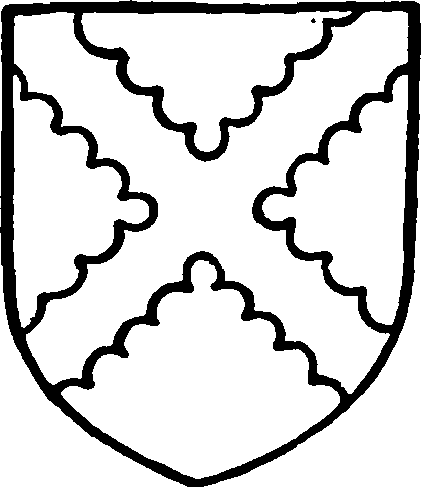
Frank. Vert a saltire engrailed or.
The tenancy in fee was held by the family of Kneeton. Elsi de Kneeton and Adam his son granted lands to St. Agatha's Abbey, (fn. 60) and later, in the 12th or early in the 13th century, Richard de Kneeton and Thomas his son granted lands here to St. Martin's Priory, Richmond, and to St. Mary's Abbey, York. (fn. 61) In the reign of Henry III an Alan de Kneeton held 12 librates of land in Middleton and Kneeton of the earl by drengage. His daughters Agnes and Cecily married Henry Maunsel and Gilbert de Newton respectively, and he had sons Walter and Ralph. (fn. 62) Perhaps his eldest son was the Alan de Kneeton who died without issue leaving Walter a brother and heir. Walter had a son and heir Alan, (fn. 63) who held 2 carucates in Kneeton and Middleton in 1280, when he made a grant to his son Henry. (fn. 64) He held a quarter-fee in these two places in 1283. (fn. 65) His son Thomas died childless and was succeeded by his sister Maud, (fn. 66) who married Geoffrey de Melsonby. (fn. 67) Geoffrey was returned as joint lord in 1316, (fn. 68) and his son John de Melsonby had succeeded by 1347–9. (fn. 69) In 1381 William de Morton and Katharine his wife conveyed their right in the reversion of half the manor of Kneeton, which Maud de Melsonby held for life, to Sir Robert de Layton, kt. (fn. 70) By 1428 Thomas Grandorge and others had succeeded the Melsonbys. (fn. 71) Possibly a daughter of Thomas may have married one of the Franks, (fn. 72) but, however this may be, William Frank (fn. 73) died in 1466–7 seised of the whole 5 carucates (fn. 74) of which Kneeton was composed, leaving a son and heir Thomas. (fn. 75) In 1496–7 Margaret Countess of Richmond is said to have given all her lands in Kneeton and Middleton to Thomas Frank at a rent of £10. (fn. 76) Thomas died seised of the manor in 1515, but he held it only by right of his deceased wife Isabel, with reversion to their son Marmaduke. (fn. 77) Marmaduke was succeeded by a son Leonard and he by a son Henry. (fn. 78) In 1584 Henry conveyed the manor to Roger Gower and Charles Johnson. (fn. 79) Henry was attainted, and Queen Elizabeth granted this manor in fee in 1585 to Anthony Collins and Lawrence Woodnett (fn. 80); they were possibly only fishing grantees, for in 1588 Roger Gower and Charles Johnson reconveyed the manor to Henry Frank, (fn. 81) who died seised in January 1592–3. His eldest son Marmaduke died in his lifetime, and Henry was succeeded by his son George, (fn. 82) on whose marriage the manor had already been settled. George died in 1607, leaving a son and heir Marmaduke. (fn. 83) Marmaduke took the Royalist side in the Civil War and Kneeton was sequestered, but finally compounded for. His daughters and heirs in 1655 were Elizabeth wife of Nicholas Salkeld and Prisca her sister. (fn. 84) Perhaps Prisca was the Priscilla who with Francis Peacock her husband in 1695–6 conveyed half the manor to Marmaduke Hartley. (fn. 85) At the same date William Irwin and Dorothy his wife (fn. 86) conveyed half the manor to Marmaduke Hartley and his heirs, (fn. 87) who in 1699–1700 obtained a conveyance of the 'manor' (perhaps only half) from Dorothy wife of William Irwin and Dorothy wife of Christopher Shaw. (fn. 88) The Hartleys, to whom there are many tablets in Middleton Tyas Church, were still living at Middleton Lodge in 1880. (fn. 89) It is now the residence of Mr. Arthur Francis Pease, D.L., J.P. In 1801 Leonard William Hartley conveyed the manor to John Hunter. (fn. 90) Sir Ralph Milbanke and Elizabeth his wife joined in a settlement of 'the manors of Moulton and Kneeton' in 1765. (fn. 91) Their granddaughter and heiress married Lord Byron the poet, and the owner's mother, Mrs. Eyre, was only sister of the present Lord Byron. (fn. 92) Mr. Colin Douglas Eyre was succeeded in 1910 by Mr. Ralph Eyre.
The second fee in Kneeton was held in 1286–7 by Roger Miniot, who had 3 carucates in demesne, while the remaining carucate and oxgang were held by under-tenants. (fn. 93) In 1285 he obtained a grant of free warren in his demesne lands, and this was allowed to him in 1289. (fn. 94) In 1302–3 he was said to hold one-third of a knight's fee in Kneeton and Middleton, (fn. 95) but he is not again mentioned. Possibly at his death his demesnes may have come into the hands of his chief under-tenant, Henry de Middleton, (fn. 96) or his successors, for in 1347–9 the heir of William de Middleton and John Melsonby were said to hold the third part of a knight's fee here that had once been held by Roger Miniot. (fn. 97) In 1428 this third of a fee was held by Alice widow of William Middleton, Robert Middleton, Thomas Grandorge and others. (fn. 98)
MOULTON (Molton, xi cent.; Multona, xii cent.; Mowlton, xvi–xvii cent.) was held by the count in demesne in 1086. (fn. 99) It afterwards followed the same descent as the manor of Arkengarthdale (fn. 100) (q.v.) until that came to the Crown in 1483, and in 1628, when Arkengarthdale was sold with Middleham to the citizens of London, a rent from the farm of the manor of Moulton was included in the conveyance. (fn. 101)
The Dowager Duchess of Bedford, by right of her dower of the Richmond lands, held a court here in 1441. (fn. 102)
In 1278 a grant was ratified by which the earl gave the capital messuage of Moulton and its demesne lands with other lands to the value of £25 yearly to the abbey of Egglestone, to support six chaplains in Richmond Castle (fn. 103); but according to an extent of the earl's possessions in 1285 he had a capital messuage and water-mill here, and the Abbot of Egglestone, the Knights Templars, Simon de Moulton (fn. 104) and Alexander the Smith held under him as free tenants. (fn. 105) His free warren is mentioned in 1310. (fn. 106)
Christopher Rokeby subsequently had the Hospitallers' lands, and in February 1580–1 granted them to Sir George Bowes (fn. 107) of South Cowton. (fn. 108)
Roger Radcliffe of Mulgrave had the 'manor' in 1585; his son and heir Francis (fn. 109) died seised in 1591–2, leaving a son and heir Roger. (fn. 110) In 1601 Ralph Radcliffe and William Radcliffe conveyed tenements in Moulton to Christopher Smithson and John Boulton. (fn. 111) The other part of the Templars' lands also came to the Smithsons. Anthony Bulmer died seised of a quarter of the manor of Moultoncum-Gatherley in 1584, leaving a son and heir Bertram, (fn. 112) who in 1609–10 conveyed the manor of Gatherley with Moulton to Christopher Smithson. (fn. 113) In 1664 a warrant was issued for a discharge to George Smithson of Moulton of £10 16s. 8d., the fee-farm rents of Moulton and of other lands held by him. (fn. 114) In 1765 and 1821 (fn. 115) the manor of Moulton was in the possession of the Milbankes. Its later descent is obscure, but it probably now belongs to the Eyres.
Church
The church of ST. MICHAEL has a chancel 30 ft. by 16 ft. with a north vestry, nave 62 ft. long and tapering from 16 ft. 3 in. to 14 ft. 3 in. in width, north aisle 7 ft. 6 in. wide, south aisle from 8 ft. to 9 ft. wide, a south porch and a western tower 11 ft. 6 in. square, all interior measurements.
The irregularity of the plan is very marked, and the evidence which has survived modern repairs points to a very interesting process of development. The north arcade of the nave dates from c. 1140, and at that time the nave must have been of the abnormal proportion of 60 ft. by 13 ft. That this was not the earliest condition of the building is suggested by the north-east quoin of the nave, which is probably that of an aisleless nave of the beginning of the 12th century. The normal length of such a nave, given its width of 13 ft., would be about 30 ft., and it is probable that such a one existed here till the addition of a north aisle in 1140, when its length was exactly doubled, bringing it to the usual length of a Romanesque nave of the larger parochial size. That it was not also widened at this time is proved by the fact that the western tower, added in the 13th century, is set centrally with the original narrow nave. In the 13th century the chancel was rebuilt, being as usual widened, and owing to the narrowness of the nave its south wall was built well outside the line of the south wall of the nave. There was probably a south aisle to the nave at the time, but no evidence of it remains. The north aisle walls also seem to have been rebuilt in the 13th century, and in the 14th the present south arcade of the nave was set out to the south of the line of the original south wall abutting at one end against the south wall of the chancel and at the other against that of the tower, the width of the nave being thus increased by 3 ft. at the east and 15 in. at the west. The south wall of the aisle is parallel neither with the old line of the nave nor with the 14th-century arcade, and may be in part earlier than the latter.
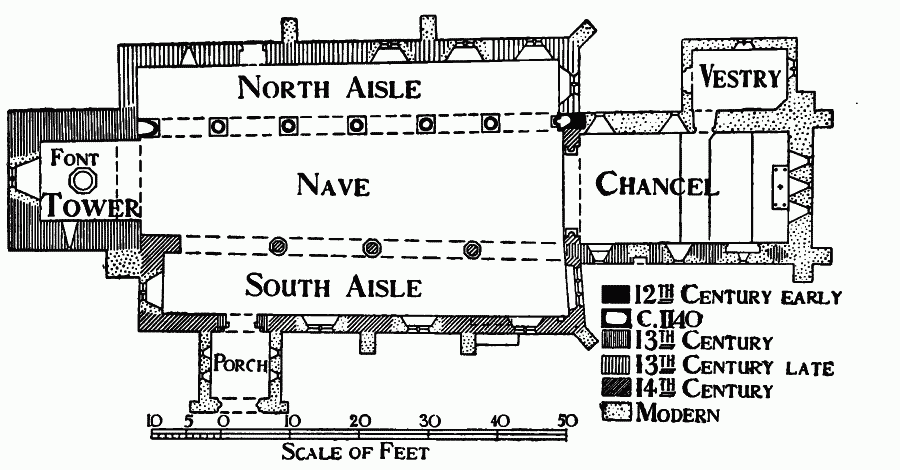
Plan of Middleton Tyas Church
In modern times (1868) the chancel was practically rebuilt and lengthened and a north vestry added, the chancel arch heightened and a south porch built to the nave; much of the window tracery is also new.
All the chancel windows but that at the southwest are modern lancets; the south-west window is a 13th-century lancet, its lower part cut off by a transom and forming a rebated low-side window. Close to it on the east is a small blocked 13th-century doorway, and the internal jamb of the window next to it is also old and probably of the same date. The chancel arch has jambs, renewed in parts, with attached shafts and simply moulded capitals and bases; the arch is of two chamfered orders. The nave has a north arcade of six bays with semicircular arches of two square orders, with chamfered labels towards the nave. The central column is octagonal and the rest are circular, with half-round responds at east and west, the former of much less diameter than the latter. All have scalloped capitals with slight differences in detail, the abaci being square with a chamfer beneath, and the bases have triangular spurs, only three of them being old. In the east respond, about 5 ft. 6 in. above the floor, is a stone shelf set askew towards the south; it was probably for an image.
The south arcade is of four bays with pointed arches of two chamfered orders. In the responds the inner orders are carried on moulded corbels and the outer orders die into the walls. The columns are octagonal, the eastern one having a moulded bellcapital carved with naturalistic leaves, while the others have small bells, and a greater number of moulded members. The base of the eastern column is rather more carefully treated than the others, and, as the Lady altar was probably at the east end of the south aisle, the more careful ornament of this column may be due to its position.
The north aisle has an east window of two trefoiled lights with a quatrefoiled circle in the head, of late 13th-century style and apparently ancient; in the north wall are three two-light windows, of which only the easternmost is old. It has a pair of lancets with their heads in one stone, and a square lintel, the others having similar lancets with a trefoiled piercing over, under a two-centred arch. Further west is the north doorway, of two continuous chamfered orders, apparently 13th-century work, as is a small lancet near it on the west. There is no west window to this aisle.
The east window of the south aisle is of a most unusual form, being quadrant shaped, divided into three lights by vertical mullions; it has no cusping, and seems intended to resist the thrust of the chancel arch. The three south windows are modern, of two lights, and the south doorway is 14th-century work with small shafts in the jambs, under a modern porch. A small piscina occupies the usual position at the east end of the south wall; it has a half-round basin and trefoiled head; to the west of it is a 14th century tomb recess, 7 ft. 4 in. wide, spanned by a trefoiled arch in a crocketed gabled head, the greater part of which has been replaced in plain stonework. In the recess is a beautifully carved coffin lid with a crosshead of eight interlaced trefoils, the surface and the edges of the stone being richly carved with natural foliage. Its date must be c. 1300. The west window of the aisle is modern and like those in the south wall.
The tower is of four stages, each with chamfered offsets; it opens to the nave by a plastered arch of doubtful date, and the west window of the ground stage is modern. On the south side of this stage is a small rectangular light, which is old, and in the second stage are small lancet windows on the west and south. The third stage is lighted on the north by a small rectangular window, and the fourth (or bell chamber) has on the north, west and south a pair of lancets divided by a shaft; the shafts are modern. The east wall shows signs of having once had a similar window. The tower is finished by a modern moulded parapet, above which rises an octagonal leaded spire put up in 1868. In the angle of the tower with the south aisle is a large square block of masonry reaching up to about half the height of the second stage; it seems to be nothing but a buttress.
The octagonal font is modern, of 13th-century style. The pulpit, seats, &c., date from 1868, and the oak chancel screen, which is of good design, is of more recent date.
Besides the coffin lid already mentioned there is another coped stone now standing beside the north doorway. It has a roll edge in the form of a Latin cross, and on the right side a shield with a chief and two gimel bars. There are also the arm of an early cross-head and other fragments. In the churchyard lies a 15th-century slab with the indents of two brass figures with scrolls issuing from their shoulders and a space for an inscription below. Another stone inscription marks the grave of an inhabitant who died in 1783 at the age of 103.
In the chancel is a memorial to a forgotten worthy, the Rev. John Mawer, who died in 1763, the master of twenty-two languages. Frederick Prince of Wales intended to send him to christianize Abyssinia, but died before doing so, 'to the great mortification of this excellent person, whose merits meeting with no reward in this world will, it's to be hoped, receive it in the next, from that Being which Justice only can influence.'
There are three bells in the tower; the second
bears in beautiful Gothic capitals of the 14th century
'+ Consono quanto sono Michaeli cantica dono.
Hinc Michi: de celis fluxit nomen Michaelis.' Over
the initial cross is a dragon. The treble bears an
inscription set backwards and wrongly divided up,
but here given in its correct form:—
armigeri laudes resono de kneton ad auras
cum voce proclamo mistica sacra dei. 1662,
with a shield which seems to bear a pale; the tenor
has the inscription 'God savee (sic) his church 1665.'
The plate consists of a cup and large banded paten, together with a small modern plated paten and flagon.
The registers begin in 1539.
A curious relic of the 18th century still preserved in the church is an old wooden pitch pipe, which was used to set the note for chanting and singing hymns.
Advowson
The church of Middleton was given by Ughtred son of Ulf to the abbey of St. Mary at York, and was confirmed to the abbey by Henry II (fn. 116) and Count Stephen of Britanny. (fn. 117) After the Dissolution the advowson was retained by the Crown until 1860, (fn. 118) when it was transferred to the Bishops of Ripon, (fn. 119) now patrons. The vicarage is mentioned in 1292. (fn. 120)
The rectory was appropriated to the abbey, (fn. 121) and the church dowered with 1 carucate of land. (fn. 122) The vicar now divides the tithes with the lay rector and keeps the south side of the chancel in repair. (fn. 123)
The chantry in the parish church mentioned in 1547 had for its purpose the performance of divine service and the assistance of the curate in administering sacraments, there being 200 'houseling people' in the parish. (fn. 124) It was granted in 1549–50 to William Winlow and others. (fn. 125) In 1543 Thomas Smithson of Cowton Grange bequeathed 8d. to the rood light in this church. (fn. 126) Adam de Kneeton some time in the late 12th or early 13th century gave tenements to the parish church, and in return the Abbot of St. Mary's, York, granted him, with the consent of the parsons of the said church, who celebrated divine offices on the fourth and sixth days of the week in the chapel of St. James of Kneeton, a chaplain in the said chapel. (fn. 127) The invocation of the chapel seems to have been changed, for in 1585, on the attainder of Henry Frank, Magdalen Chapel at Kneeton was granted with the manor to Anthony Collins and Lawrence Woodnett. (fn. 128) No further mention has been found, but it is generally supposed that there was a domestic chapel attached to Kneeton Hall and that its foundations may be traced. (fn. 129) In 1586 a chapel in the village street of Moulton was granted by the Crown to John Awbrey and John Radcliffe. (fn. 130) This 'small dilapidated edifice' is now inhabited by the village carpenter. (fn. 131) There is a chapel of ease there built by the late W. Ward and the property of Sir Jonathan E. Backhouse, bart.
David Whitford, the 'soldier and scholar,' (fn. 132) obtained dispensation in 1674 to hold the vicarage of Middleton Tyas with the vicarage of Manfield. (fn. 133)
Charities
The Poor's Folk Close, the origin of which is unknown, contains about 3 a. and is let in allotments producing £6 a year, which in 1906 was distributed to twelve poor people, together with a sum of 30s. a year, under the name of Thomas's Dole, being the interest on £30 lent on personal security, of which £20 is understood, from an entry in the parish register, to be the gift of John Shaw, who died in 1636.
Township of Moulton.—It appears from the parish register that John Allen, who died in 1646, gave out of his land at Gatherley 16s. yearly for ever to the poor of Middleton parish. The annuity is paid by Miss Barningham of Gatherley Castle and distributed to poor widows.
